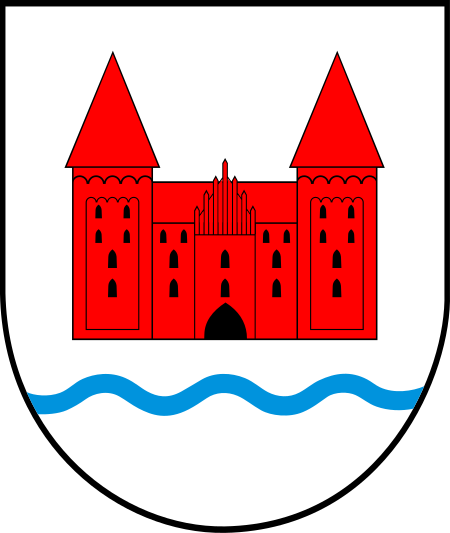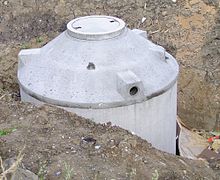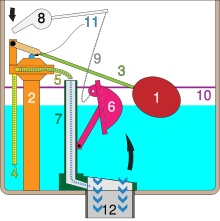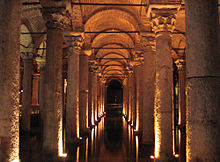Cistern
|
Read other articles:

Species of fish Ohrid trout Conservation status Data Deficient (IUCN 3.1)[1] Scientific classification Domain: Eukaryota Kingdom: Animalia Phylum: Chordata Class: Actinopterygii Order: Salmoniformes Family: Salmonidae Genus: Salmo Species: S. letnica Binomial name Salmo letnica(S. Karaman, 1924) Ohrid trout[2][1] or the Lake Ohrid brown trout[3] (Salmo letnica) is an endemic species of trout in Lake Ohrid and in its tributaries and outlet, the Black Dri…

508 Pal Putih Halte TransjakartaHalte Pal Putih pada Januari 2024LetakKotaJakarta PusatDesa/kelurahanKramat, SenenKodepos10450AlamatJalan Kramat RayaKoordinat6°11′04″S 106°50′38″E / 6.1845°S 106.8439°E / -6.1845; 106.8439Koordinat: 6°11′04″S 106°50′38″E / 6.1845°S 106.8439°E / -6.1845; 106.8439Desain HalteStruktur BRT, median jalan bebas 1 tengah Pintu masukMelalui jembatan penyeberangan di Jalan Kramat RayaGerbang tari…

Constituency of Bangladesh's Jatiya Sangsad Natore-4Constituencyfor the Jatiya SangsadDistrictNatore DistrictDivisionRajshahi DivisionElectorate371,788 (2018)[1]Current constituencyCreated1984PartyAwami LeagueMember(s)Siddiqur Rahman Patwari Natore-4 is a constituency represented in the Jatiya Sangsad (National Parliament) of Bangladesh since 2023 by Siddiqur Rahman Patwari of the Awami League. Boundaries The constituency encompasses Baraigram and Gurudaspur.[2][3] Histor…

2005 United States gubernatorial elections ← 2004 November 8, 2005 2006 → 3 governorships2 states; 1 territory Majority party Minority party Party Republican Democratic Seats before 28 22 Seats after 28 22 Seat change Seats up 0 2 Seats won 0 2 Map of the results Democratic hold Covenant gain No election United States gubernatorial elections were held on Nove…
周處除三害The Pig, The Snake and The Pigeon正式版海報基本资料导演黃精甫监制李烈黃江豐動作指導洪昰顥编剧黃精甫主演阮經天袁富華陳以文王淨李李仁謝瓊煖配乐盧律銘林孝親林思妤保卜摄影王金城剪辑黃精甫林雍益制片商一種態度電影股份有限公司片长134分鐘产地 臺灣语言國語粵語台語上映及发行上映日期 2023年10月6日 (2023-10-06)(台灣) 2023年11月2日 (2023-11-02)(香港、…
2020年夏季奥林匹克运动会波兰代表團波兰国旗IOC編碼POLNOC波蘭奧林匹克委員會網站olimpijski.pl(英文)(波兰文)2020年夏季奥林匹克运动会(東京)2021年7月23日至8月8日(受2019冠状病毒病疫情影响推迟,但仍保留原定名称)運動員206參賽項目24个大项旗手开幕式:帕维尔·科热尼奥夫斯基(游泳)和马娅·沃什乔夫斯卡(自行车)[1]闭幕式:卡罗利娜·纳亚(皮划艇)[2…

يفتقر محتوى هذه المقالة إلى الاستشهاد بمصادر. فضلاً، ساهم في تطوير هذه المقالة من خلال إضافة مصادر موثوق بها. أي معلومات غير موثقة يمكن التشكيك بها وإزالتها. (ديسمبر 2018)Learn how and when to remove this message تنتشر في الأردن 23 إذاعة تبث عبر موجة لإف إم منها ما هو خاص ومنها ما هو عام للدولة إذاع…

Seti IChân dung Seti I tại đền thờ ở AbydosPharaonVương triều1290–1279 TCNTiên vươngRamesses IKế vịRamesses IITên hiệu Tên ngai (Praenomen) Menmaatre Sự vĩnh cửu là sức mạnh của Ra Tên riêng Seti MerenptahNgười của thần Seth, Ptah yêu quý Tên Horus Kanakht Khaemwaset-SeankhtawyBò đực khỏe mạnh, lớn lên tại Thebes, người ban sự sông cho 2 vùng đất Tên Nebty (hai quý bà) Wehemmesut Sekhemkhepesh DerpedjetpesdjetN…

هذه المقالة يتيمة إذ تصل إليها مقالات أخرى قليلة جدًا. فضلًا، ساعد بإضافة وصلة إليها في مقالات متعلقة بها. (ديسمبر 2017) HD 290327 b تاريخ الاكتشاف 19 أكتوبر 2009 وسيلة الاكتشاف تحليل دوبلر الطيفي[1] رمز الفهرس HD 290327b (فهرس هنري درابر)TIC 4205424b (TESS Input Catalog) نصف المحور الرئيسي 3.43…

Election in Nebraska Main article: 1896 United States presidential election 1896 United States presidential election in Nebraska ← 1892 November 3, 1896 1900 → Nominee William Jennings Bryan William McKinley Party Democratic Republican Alliance Populist – Home state Nebraska Ohio Running mate Arthur Sewall(Democratic)Thomas E. Watson(Populist) Garret Hobart Electoral vote 8 0 Popular vote 115,007 103,064 Percentage 51.53% 46.18% County Results B…

هات تاريخ التأسيس 1374 تقسيم إداري البلد أوكرانيا الإمبراطورية النمساوية الإمبراطورية النمساوية المجرية خصائص جغرافية إحداثيات 48°19′13″N 22°38′22″E / 48.320277777778°N 22.639444444444°E / 48.320277777778; 22.639444444444 المساحة 4.15 كيلومتر مربع السكان التعداد السكاني 3122 (2001) …

Untuk hotel lain bernama sama, lihat Imperial Hotel (disambiguasi). Hotel ImperialHotel Imperial di Wina, AustriaInformasi umumLokasiRingstraße,Wina, AustriaDibuka1873PemilikAl Habtoor InvestmentManajemenStarwood HotelsDesain dan konstruksiArsitekArnold ZenettiPengembangHeinrich AdamSitus webwww.imperialvienna.com Hotel Imperial, yang juga dikenal sebagai The Imperial, adalah sebuah hotel mewah bintang lima di Wina, Austria. Hotel tersebut terletak di Ringstraße, Kärntner Ring 16.[1] …

Historic public pool in Austin, Texas United States historic placeDeep Eddy Bathing BeachU.S. National Register of Historic PlacesU.S. Historic district Deep Eddy PoolLocation401 Deep Eddy Ave.Austin, Texas, USACoordinates30°16′35″N 97°46′23″W / 30.27639°N 97.77306°W / 30.27639; -97.77306Area9 acres (3.6 ha)BuiltJuly 1936 (1936-07)ArchitectDan Driscoll, Delmar GroosArchitectural styleNPS RusticNRHP reference No.03000560[1]…

Spanish rally driver (born 1983) In this Spanish name, the first or paternal surname is Sordo and the second or maternal family name is Castillo. Dani SordoSordo in 2014Personal informationNationality SpanishFull nameDaniel Sordo CastilloBorn (1983-05-02) 2 May 1983 (age 41)Puente San Miguel, CantabriaWorld Rally Championship recordActive years2003–presentTeamsKronos Citroën, Citroën, Mini, Ford, HyundaiRallies182Championships0Rally wins3Podiums54Stage wins219Total poin…

Final Piala Winners Eropa 1984TurnamenPiala Winners Eropa 1983–1984 Juventus Porto 2 1 Tanggal16 Mei 1984StadionStadion St. Jakob, BaselWasitAdolf Prokop (Jerman Timur)Penonton60.000← 1983 1985 → Final Piala Winners Eropa 1984 adalah pertandingan final ke-24 dari turnamen sepak bola Piala Winners Eropa untuk menentukan juara musim 1983–1984. Pertandingan ini mempertemukan tim Italia Juventus dengan tim Portugal Porto dan diselenggarakan pada 16 Mei 1984 di Stadion St. Jakob,…

Questa voce sull'argomento centri abitati della Varmia-Masuria è solo un abbozzo. Contribuisci a migliorarla secondo le convenzioni di Wikipedia. NidzicacomuneNidzica – Veduta LocalizzazioneStato Polonia Voivodato Varmia-Masuria Distretto Nidzica AmministrazioneSindacoDariusz Szypulski TerritorioCoordinate53°21′30″N 20°25′30″E53°21′30″N, 20°25′30″E (Nidzica) Superficie378,88 km² Abitanti21 480 (2004) Densità56,69 ab./km² Altre informazioniP…

В Википедии есть статьи о других людях с фамилией Манукян. Ирина Эдуардовна Манукян Основная информация Дата рождения 22 августа 1948(1948-08-22) Место рождения Москва, СССР Дата смерти 3 мая 2004(2004-05-03) (55 лет) Место смерти Москва, Россия Похоронена Введенское кладбище Стр…

Apple > iPad > iPad Pro > 12.9インチiPad Pro (第5世代) iPad Pro 製造元 Apple種別 タブレット (コンピュータ)世代 第5世代発売日 2021年5月21日OS iPadOS 14.5(初期搭載)→ iPadOS 17.2SoC Apple M1 8コア ARM64メモリ 8GB16GB(1TB/2TBモデル) (LPDDR4X)ストレージ フラッシュメモリ128GB,256GB,512GB,1TB,2TBディスプレイ 12.9インチ (330 mm) 4:3アスペクト比 画面解像度:2732 x 2048px(264ppi)、4:3…

2010 film TwelveTheatrical release posterDirected byJoel SchumacherScreenplay byJordan MelamedBased onTwelveby Nick McDonellProduced by Sidonie Dumas Ted Field Charlie Corwin Jordan Melamed Robert Salerno Starring Chace Crawford Rory Culkin Curtis Jackson Emily Meade Emma Roberts Narrated byKiefer SutherlandCinematographySteven FierbergEdited by Paul Zucker Gordon Grinberg Music byHarry Gregson-WilliamsProductioncompanies Gaumont Radar Pictures Original Media Distributed by Hannover House (Unite…

L'équipe des Samoa exécutant le Siva tau avant le match contre la France lors de la Coupe du monde de rugby à XIII 2013. L'équipe des Samoa effectuant son Siva Tau avant le match contre l'Afrique du Sud lors de la Coupe du monde de rugby à XV 2007. Le siva tau est une danse samoane exécutée par l'équipe des Samoa de rugby à XV et l'équipe des Samoa de rugby à XIII avant chaque match. Inspiré des danses guerrières traditionnelles, le siva tau a été composé durant les années 1980 …












![Aljibe of the Palacio de las Veletas [es], Cáceres, Spain](http://upload.wikimedia.org/wikipedia/commons/thumb/5/57/Palacio_de_las_Veletas%2C_aljibe%2C_C%C3%A1ceres.JPG/120px-Palacio_de_las_Veletas%2C_aljibe%2C_C%C3%A1ceres.JPG)


